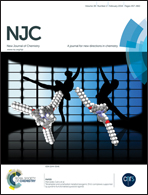An RAPET approach to in situ synthesis of carbon modified Li4Ti5O12 anode nanocrystals with improved conductivity
Abstract
Carbon modified lithium titanate (Li4Ti5O12) anode nanocrystals for Li-ion batteries were synthesized by directly treating the titanium alkoxide and lithium acetate ethanol solution via the Reaction under Autogenic Pressure at Elevated Temperature (abbreviated to RAPET). The mixture of the liquid precursors decomposed during the RAPET process and then reacted in situ and transformed into carbon-modified Li4Ti5O12 anode nanocrystals. The organic moieties in the titanium alkoxide and the lithium salt provided both the oxygen and carbon for the synthesis. The resulting products were characterized by X-ray diffraction (XRD), elemental analysis, scanning electronic microscopy (SEM), high resolution transmission electron microscopy (HR-TEM), nitrogen adsorption–desorption measurements, cyclic voltammetry (CV), electrochemical impedance spectroscopy (EIS), and galvanostatic charge–discharge testing. The influences of the titanium alkoxide precursors, i.e. the length of the alkoxy group, on the properties of the final products and the presence of the in situ resulting carbon on the electrochemical performance have been investigated.


 Please wait while we load your content...
Please wait while we load your content...